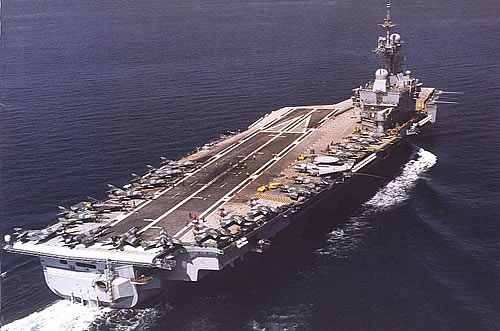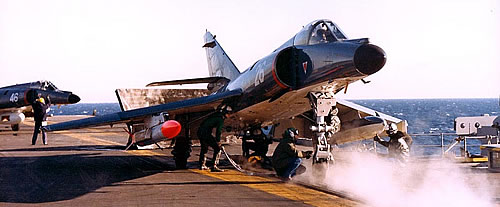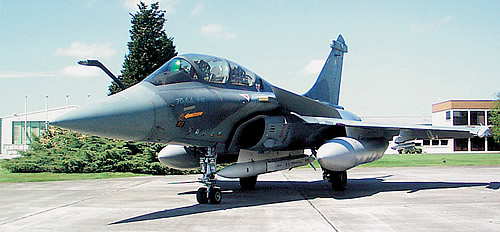French Aircraft Carrier Sails Without Nukes
 |
| The French nuclear-powered aircraft carrier Charles de Gaulle with air wing on deck. |
By Hans M. Kristensen
France no longer deploys nuclear weapons on its aircraft carrier Charles de Gaulle under normal circumstances but stores the weapons on land, according to French officials.
President Nicolas Sarkozy declared in March 2008 that France “could and should be more transparent with respect to its nuclear arsenal than anyone ever has been.” But while the other nuclear powers declared long ago that their naval weapons were offloaded or scrapped after the Cold War ended, a similar announcement has – to my knowledge – been lacking from France.
The French acknowledgment marks the end of peacetime deployment of short-range nuclear weapons at sea.
It is not clear when the French offload occurred; it may have been instigated years ago. But it completes a worldwide withdrawal of short-range nuclear weapons from the world’s oceans that 20 years ago included more than 6,500 British, French, Russian, and U.S. cruise missiles, anti-submarine rockets, anti-aircraft missiles, depth bombs, torpedoes and bombs.
Nuclear Charles de Gaulle
The nuclear-powered aircraft carrier Charles de Gaulle carries a squadron of Super Étendard bombers equipped with the ASMP nuclear cruise missile. From 2010 these aircraft will be replaced with the Rafale MK3 (navy version) equipped with a new nuclear cruise missile known as the ASMP-A. The weapon will enter service with air force’s Mirage 2000Ns this fall and next year with the Rafale F3.
|
ASMP on Super Étendard |
 |
| A Super Étendard prepares to take off from an aircraft carrier with an ASMP nuclear cruise missile shape under its right wing. |
France previously operated two aircraft carriers, the Clemenceau and Foch, with nuclear capability. Initially armed with nuclear bombs, the ships were upgraded to the ASMP in the late 1980s, but decommissioned in 1997 and 2000, respectively. Plans to replace them with two nuclear-powered carriers did not materialize; only the Charles de Gaulle has been built.
|
ASMP-A on Rafale F3 |
 |
| A Rafale F3 aircraft with an ASMP-A nuclear cruise missile shape installed on the center pylon. |
With a range of only 300 km (500 km for the ASMP-A), the cruise missile strictly speaking falls into the category of U.S. and Russian non-strategic weapons, but France calls its cruise missile strategic or pre-strategic. Technically, the range of the aircraft delivering the cruise missile extends the range to 2,000-2,500 km, similar to the U.S. nuclear Tomahawk land-attack cruise missile and the Russian SS-N-21. But that assumes the aircraft will be able to penetrate the air defenses of the target country. Regardless, potential adversaries probably care less about the category terminology than the fact that the weapon is nuclear.
During normal circumstances the cruise missiles are stored on land, perhaps in a weapons storage area close to the carrier’s homeport in Toulon. The weapons storage spaces onboard the Charles de Gaulle are maintained and the crew periodically trained and certified to store and handle the missiles so they can quickly be brought onboard if a decision is made to deploy the them.
As for the Charles de Gaulle’s nuclear strike mission, it can hardly be said to be essential; During the extended time periods the carrier is in overhaul (18 months), France does not have a sea-based nuclear cruise missile capability.
Additional Information: French Nuclear Forces 2008
The FY2026 National Defense Authorization Act (NDAA) paints a picture of a Congress that is working to both protect and accelerate nuclear modernization programs while simultaneously lacking trust in the Pentagon and the Department of Energy to execute them.
While advanced Chinese language proficiency and cultural familiarity remain irreplaceable skills, they are neither necessary nor sufficient for successful open-source analysis on China’s nuclear forces.
Satellite imagery has long served as a tool for observing on-the-ground activity worldwide, and offers especially valuable insights into the operation, development, and physical features related to nuclear technology.
This report outlines a framework relying on “Cooperative Technical Means” for effective arms control verification based on remote sensing, avoiding on-site inspections but maintaining a level of transparency that allows for immediate detection of changes in nuclear posture or a significant build-up above agreed limits.